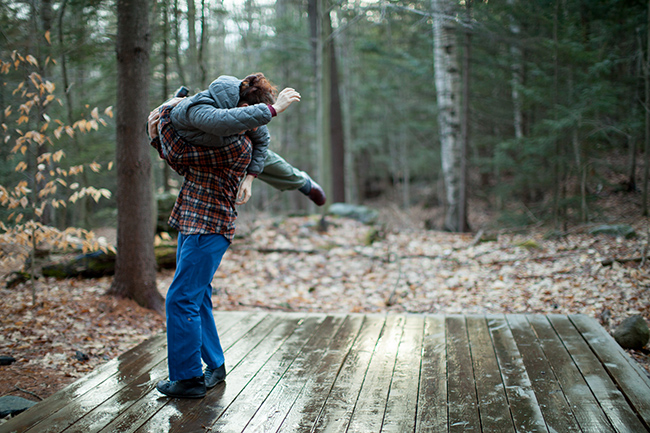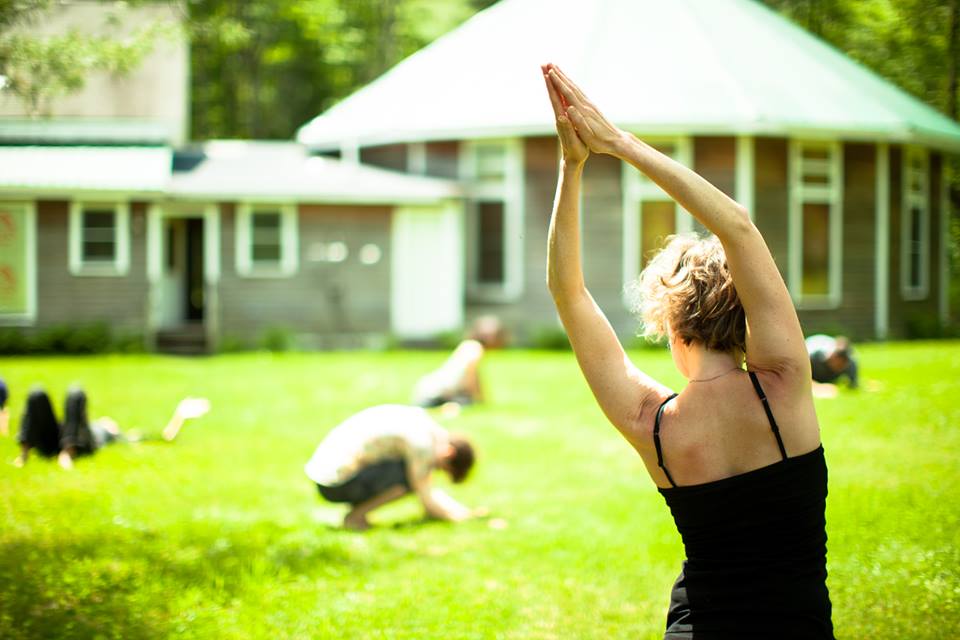Earthdance: A Different Way of Living and Dancing
An Interview with Sarah Young
BY EMMALY WIEDERHOLT
Sarah Young is the executive director of Earthdance, an artist-run workshop, residency and retreat center located on 125 acres of land in the Berkshire hills of western Massachusetts. This interview is part of Where Dance Is, a series of interviews with dance artists working in rural places.
Photo by Anna Maynard
~~
Can you give a short history of Earthdance?
In 1986, there was a group of people in Boston who desired a more intentional community with dance as an important component. Legend has it that half the group wanted to build this in the city and so stayed in Boston, while the other half wanted to live in a more rural area. They came to Western Massachusetts because Florence, MA is where Nancy Stark Smith and Lisa Nelson have built the Contact Quarterly headquarters, and they wanted to be in the vicinity of that contact improvisation scene. They researched land nearby and ended up in Plainfield, MA, where they started Earthdance.
Over the past 30 years, Earthdance has been growing as a workshop, retreat and residency center with a focus on improvisational movement, ecological stewardship and social justice practices. The community has grown to include people who live, work and attend events here, as well as those who have ended up settling in this area because of connections they developed through Earthdance.
How did you come to find yourself at Earthdance?
I’d been living, dancing, performing and teaching in New York City for about five years, then served as a Peace Corps volunteer in the Atlas Mountains of southern Morocco from 2008 to 2010. I got married in Morocco and moved back to Brooklyn with my husband following my Peace Corps service. I wasn’t quite feeling satisfied with the dance track I’d been on, in which I was performing with various small companies and trying to survive in the city. So when the opportunity for the directorship opened up at Earthdance, I decided to apply. I had only been to Earthdance twice, and I pursued the opportunity because I was attracted to the idea of living in nature and engaging in dance in a different way than I had been. I was hired as the director in February 2013, and have been serving in the role since.
What does your current dance practice look like?
It’s really dynamic. That’s one of the things I like about it: I have been able to integrate more parts of myself than previously. In New York, I followed a routine like, “Every Tuesday morning I go teach dance and on Mondays, Wednesdays and Fridays I have rehearsal from 10 to noon.” Now there is much more integration. We might have a spontaneous jam in the kitchen at lunch time. We had an amazing improvisation workshop with Sara Shelton Mann recently, and we researched improvisational tools throughout the entire weekend. I do a weekly Underscore practice with Nancy Stark Smith, and I teach Feldenkrais lessons to our staff on Mondays. Various performing opportunities come up three to four times a year.
We have a live-work staff of about 12 people here at Earthdance, and most of us are dancers. It’s very common for us to say, “Let’s do an hour of Authentic Movement,” or come together to jam and share creative research. It becomes a practice as opposed to a schedule. It also means we’re following the impulse to go to the studio rather than to following other distractions. The way I work now tends to blend one moment into the next, whether it’s writing, dancing, solving a financial challenge, designing a workshop or festival, or taking a walk in the woods. I lose the distinctions between when I’m dancing and when I’m not.
Outside of Earthdance, how would you describe the general dance scene where you live?
There’s an incredible amount of dance here. When I moved from New York, I thought I was going to have to take up knitting to pass the time, but I’ve been blown away. There are contact improvisation jams in the general area almost every night of the week. Between Northampton, Greenfield, the Five College Dance Department, Nancy Stark Smith and Contact Quarterly, there’s lots of contact improvisation, ecstatic dance and Barefoot Boogies. Earthdance is also situated close to the Berkshires where Jacob’s Pillow Dance Festival takes place every year, which draws renowned dance professionals . So there’s a blend of dance for pleasure and building connection as a community, as well as for artistic research and focused inquiry. It’s important to have this blend. I’m inspired by the dance-makers who are challenging the field, and I also value the opportunity to not always experience dance as a product, that it can just be fun and a great way to use our bodies.
What are the benefits and drawbacks to living and working at Earthdance?
The strength of this place is that people can come as they are, make mistakes, and not have to prove anything or be expected to create a polished piece. On the flip side, I crave critical response and rigorous practices. It’s a balance to strike, but allows for unique and special opportunities. A few years ago, Jennifer Monson shared with us a solo she had been preparing to perform at The Kitchen in NYC. There were maybe seven of us in the audience. We’re way out in the woods, so there isn’t always the awareness of the impact some of these artists are having on the field of dance, as it is known by people living in the cosmopolitan areas. But it also creates the space for these artists to shed some of their perceived identities and see their work from another angle. It’s a balance.
What do you perceive Earthdance’s impact is?
Earthdance is celebrating our 30th anniversary this year, and that’s one of the questions we’re trying to answer. It’s a little hard for me to separate what Earthdance has influenced and what the conditions are that have influenced Earthdance. The same for me too: What have I impacted and what preexisting conditions have carried me through?
There are numerous people who have commented on the uniqueness of this experiment. Earthdance is by no means the only place doing what we’re doing, but I still think it’s unique in its own way. Earthdance is a creative living project. There’s something about the impact of people coming into the space… new possibilities become available to them.
There are also tangible impacts, like the creative projects people have developed here, those who met their creative and romantic partners here, or discovered a teacher and began following a certain method. But there’s something about how people arrive here with one set of expectations or perspective, and leave with a reframed understanding of what’s possible. They begin to ask: How do we mix creative research with the mundane pieces of daily living? How do we mix inquiry in our own bodies within the context of communities? These intersectionalities are part of our impact. That, and showing this way of living and working is possible.
Any other thoughts?
Sometimes I sit around our big kitchen table here at Earthdance and have the most interesting conversations. There was a dance performer here this past weekend who was also a scientist studying cell division. Or I spoke the other day with someone doing their PhD in philosophy who had just started practicing contact improvisation. The lifestyle here has expanded my views of what it means to be successful and fulfilled through dance—and ways to integrate it into one’s livelihood—that does not have to be the path of trying to get into a company and performing. That’s not the only way to be the dancer. That’s the biggest impact Earthdance has had on me. I feel like dance is more integrated into my lifestyle and more sustainable for my well-being than I had previously imagined. There’s a way.
~~
For more information, visit www.earthdance.net.


